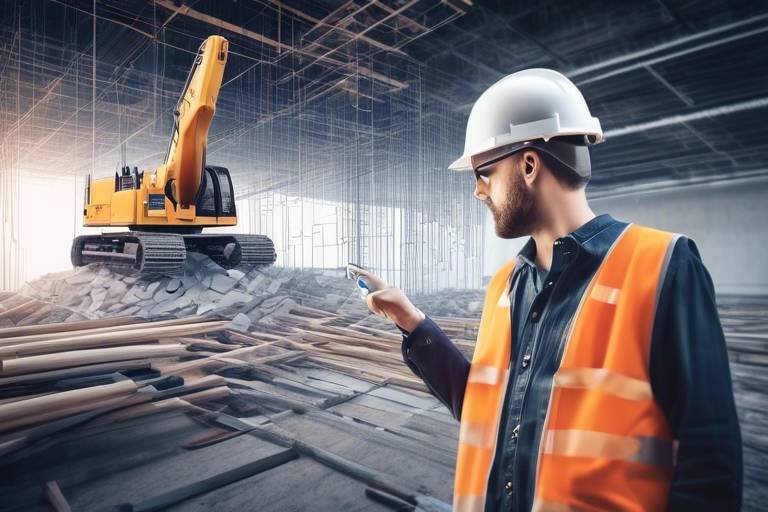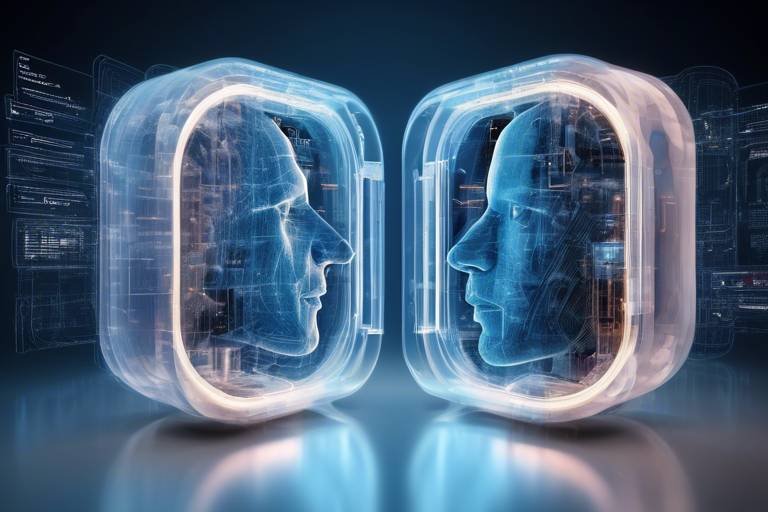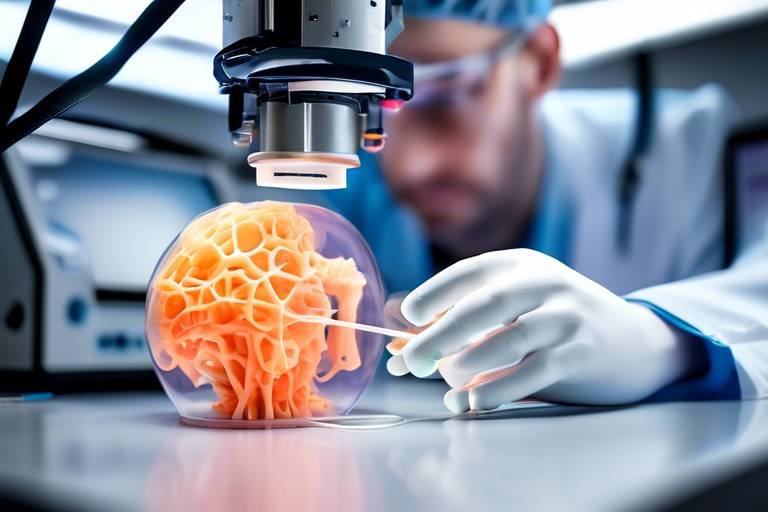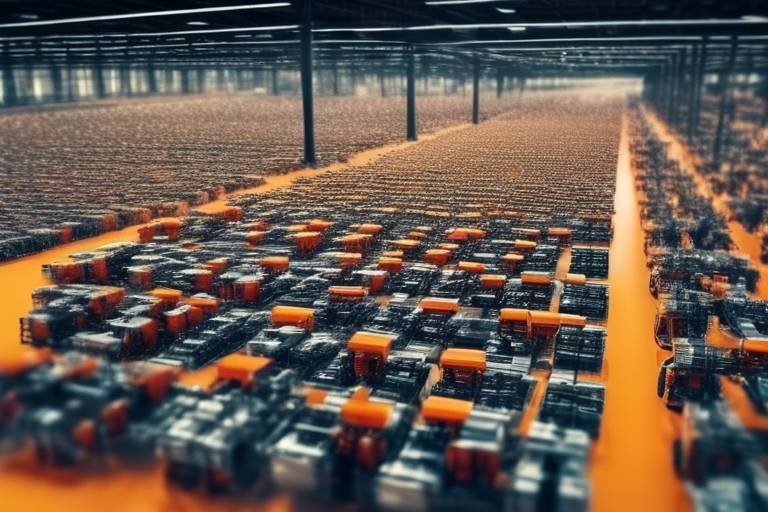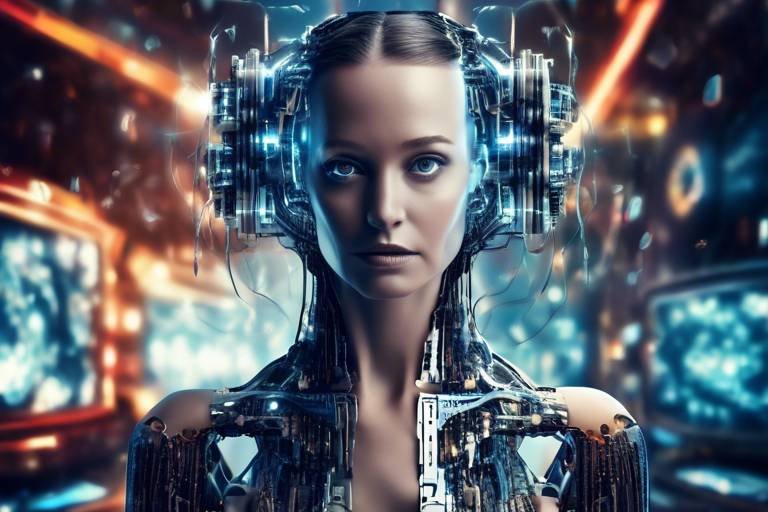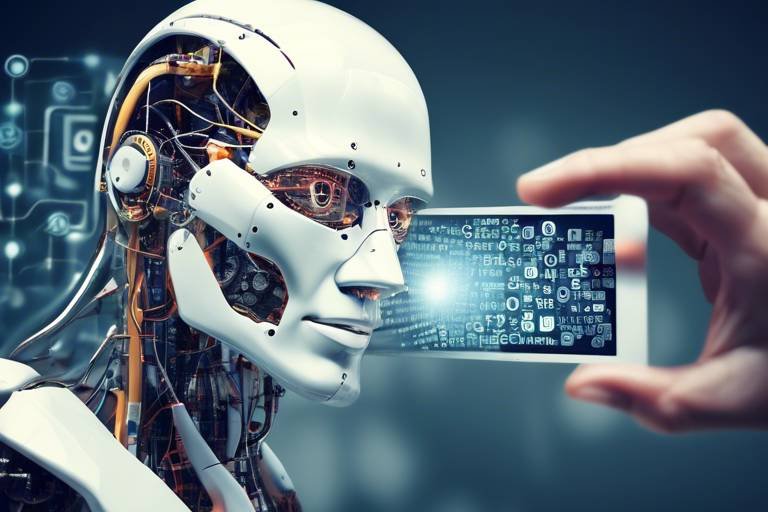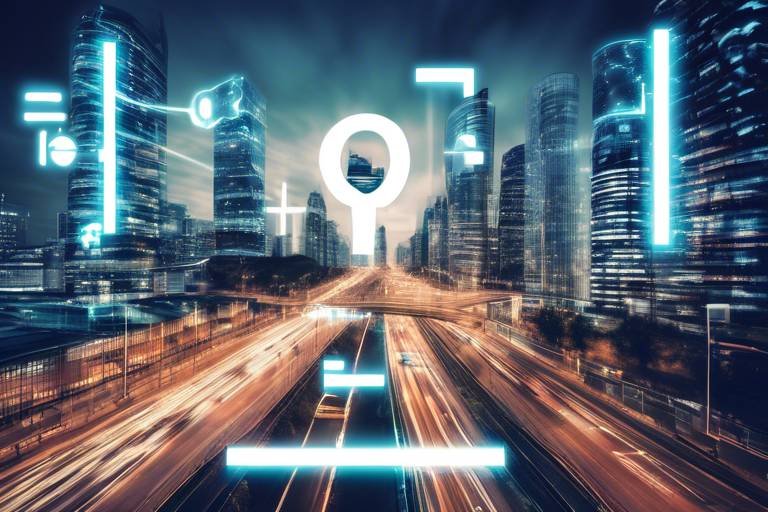Artificial Intelligence in Construction: Building a Better Future
In today's fast-paced world, the construction industry is undergoing a significant transformation, and at the heart of this revolution is artificial intelligence (AI). Imagine a world where construction projects are completed faster, safer, and more efficiently than ever before. Sounds like a dream? Well, it's becoming a reality! AI is not just a buzzword; it's a powerful tool that is reshaping how we approach building and infrastructure development. From optimizing project management to enhancing safety protocols, the integration of AI into construction is paving the way for a smarter future.
One of the most exciting aspects of AI in construction is its ability to streamline processes. Traditional project management often involves juggling multiple tasks, timelines, and resources, which can lead to inefficiencies and costly delays. However, with AI technologies, project managers can optimize scheduling, allocate resources more effectively, and improve communication among teams. This means projects can progress smoothly, reducing costs and ensuring timely completion.
But it doesn't stop there! The safety of workers on construction sites is paramount, and AI is making significant strides in this area as well. With the help of AI-driven tools, construction companies can predict hazards before they become a problem. For instance, imagine a scenario where a construction site is equipped with sensors that monitor worker behavior and environmental conditions. If a worker shows signs of fatigue or if unsafe conditions arise, the system can provide real-time alerts to prevent accidents. This proactive approach to safety is not only innovative but crucial in reducing injuries and fatalities on site.
Furthermore, AI's role extends into the design and planning phases of construction. Architects and engineers can leverage AI tools to generate optimized building plans and simulations, which significantly improves accuracy and reduces design errors. This capability ensures that the vision of a project is realized more effectively, saving time and resources in the long run.
As we look to the future, the potential of AI in construction is limitless. We can expect to see advancements in smart buildings that utilize AI for energy efficiency, autonomous machinery that can operate without human intervention, and enhanced data analytics that provide deeper insights into project performance. This evolution not only promises a more efficient construction process but also contributes to sustainability efforts, as AI helps minimize waste and optimize resource usage.
In conclusion, the integration of artificial intelligence in construction is not merely a trend; it's a revolution that is transforming the industry. With its ability to enhance project management, improve safety, streamline design processes, and reduce costs through automation, AI is indeed building a better future for construction. As we embrace these technological advancements, we can look forward to a construction landscape that is not only more efficient but also safer and more sustainable.
- How is AI used in project management? AI technologies help optimize scheduling, resource allocation, and communication, leading to improved efficiency and cost reduction.
- What safety improvements can AI provide on construction sites? AI can predict hazards, monitor worker behavior, and provide real-time alerts to enhance safety protocols.
- How does AI contribute to cost reduction in construction? By automating repetitive tasks and improving productivity, AI significantly lowers labor costs and increases efficiency.
- What are the future trends of AI in construction? We can expect advancements in smart buildings, autonomous machinery, and enhanced data analytics that will further improve the industry.

The Role of AI in Project Management
Artificial Intelligence (AI) is revolutionizing the landscape of project management in the construction industry. Imagine a world where scheduling conflicts are a thing of the past and resources are allocated with pinpoint accuracy. With AI technologies, this vision is becoming a reality. By leveraging advanced algorithms, AI streamlines project management processes, enabling construction teams to optimize their workflows and significantly enhance overall efficiency.
One of the most compelling aspects of AI in project management is its ability to analyze vast amounts of data in real-time. This allows project managers to make informed decisions quickly, adapting to changing conditions on the ground. For instance, AI can predict potential delays by analyzing historical project data and current progress. This predictive capability not only helps in avoiding costly overruns but also keeps projects on track and within budget.
Additionally, AI enhances communication among team members. Traditional project management often suffers from miscommunication and information silos, which can lead to errors and inefficiencies. AI-powered tools facilitate seamless communication by providing a centralized platform where all project-related information is accessible. This transparency fosters collaboration and ensures that everyone is on the same page, ultimately leading to better project outcomes.
Furthermore, AI can assist in resource allocation by analyzing project requirements and suggesting optimal staffing levels and equipment usage. For example, if a particular phase of construction requires more labor, AI can recommend reallocating resources from less critical tasks. This dynamic resource management not only maximizes productivity but also minimizes downtime, allowing projects to progress smoothly.
In summary, the role of AI in project management is transformative. It offers construction professionals the tools they need to enhance efficiency, improve communication, and optimize resource allocation. As the industry continues to embrace these technologies, the potential for improved project outcomes becomes increasingly apparent. The integration of AI in project management is not just a trend; it is paving the way for a smarter, more efficient construction industry.
- How does AI improve project scheduling? AI analyzes historical data and current project timelines to predict potential scheduling conflicts, allowing managers to adjust plans proactively.
- Can AI help reduce project costs? Yes, by optimizing resource allocation and improving efficiency, AI can significantly lower labor and material costs.
- What tools are available for AI-driven project management? There are numerous tools available, including software that integrates AI for scheduling, resource management, and communication.
- Is AI technology difficult to implement in construction? While there may be a learning curve, many AI tools are designed to be user-friendly and can be integrated with existing systems.

Enhancing Safety with AI
In the construction industry, safety is paramount. With the integration of artificial intelligence (AI), we are witnessing a remarkable transformation in how safety protocols are implemented and monitored on construction sites. Imagine a world where potential hazards are identified before they even pose a threat to workers. This is not just a dream; it’s a reality that AI is helping to create. By leveraging advanced algorithms and real-time data, AI-driven tools are revolutionizing safety measures, making construction sites not only more efficient but also significantly safer.
One of the most exciting aspects of AI in construction safety is its ability to predict hazards. Using predictive analytics, AI systems can analyze vast amounts of data to identify patterns and foresee potential risks. For instance, if a construction site has a history of accidents occurring during certain weather conditions, AI can alert managers to take precautionary measures when similar conditions are forecasted. This proactive approach is crucial in ensuring that safety protocols are not just reactive but anticipatory.
Moreover, AI tools are equipped to monitor worker behavior continuously. By utilizing sensors and cameras, these systems can detect unsafe practices in real-time. Imagine a worker lifting a heavy object incorrectly; AI can send immediate alerts to supervisors, prompting them to intervene before an injury occurs. This level of oversight not only enhances worker safety but also fosters a culture of accountability and awareness on-site.
Utilizing predictive analytics, AI can assess potential risks and provide insights that enable construction managers to address issues proactively. This means that instead of waiting for an accident to happen, teams can implement safety measures based on data-driven predictions. The integration of predictive analytics leads to smoother project execution and minimizes downtime caused by accidents.
At the heart of many AI safety tools are machine learning algorithms. These algorithms analyze historical data to identify patterns related to accidents and near-misses. By understanding these patterns, project managers can make informed decisions that mitigate risks. For example, if data shows that certain tasks are more prone to accidents, additional training can be provided to workers involved in those tasks, ultimately enhancing overall safety on site.
Another innovative application of AI in construction safety is the use of wearable technology. Devices such as smart helmets and vests equipped with AI capabilities can monitor workers’ health and safety in real-time. These wearables can track vital signs, detect fatigue, and even alert workers to unsafe conditions. For instance, if a worker is showing signs of extreme fatigue, the device can send an alert, prompting them to take a break. This not only protects the worker but also helps maintain productivity on-site.
In summary, the integration of AI in enhancing safety on construction sites is a game-changer. By predicting hazards, monitoring worker behavior, and utilizing advanced analytics, AI is paving the way for a safer work environment. As we continue to embrace these technologies, the construction industry can look forward to a future where safety is not just a priority but a guarantee.
- How does AI predict hazards on construction sites?
AI uses predictive analytics to analyze historical data and identify patterns that indicate potential risks, allowing managers to take preventative measures. - What role do wearable technologies play in construction safety?
Wearable devices monitor workers' health and safety, providing alerts for fatigue or unsafe conditions, which helps create a safer work environment. - Can AI improve communication regarding safety on-site?
Yes, AI tools can facilitate better communication by providing real-time alerts and updates to workers and supervisors, ensuring everyone is aware of potential hazards.

Predictive Analytics for Risk Management
In the world of construction, risk is an inevitable part of the game. However, with the advent of predictive analytics, construction managers can now turn the tide in their favor. Imagine having a crystal ball that not only identifies potential issues but also guides you on how to tackle them before they snowball into major problems. That's the power of predictive analytics in risk management! By analyzing vast amounts of historical data, AI can spot trends and patterns that human eyes might miss. This allows project managers to make informed decisions and take proactive measures, ensuring that projects run smoothly and efficiently.
One of the key benefits of predictive analytics is its ability to assess potential risks across various stages of a construction project. For instance, it can analyze data related to weather conditions, labor availability, and even equipment functionality. By integrating these data points, construction managers can foresee challenges such as delays due to bad weather or equipment breakdowns. This not only helps in mitigating risks but also enhances overall project planning.
To illustrate this further, consider a construction project that relies heavily on concrete pouring. Predictive analytics can forecast the likelihood of rain on the scheduled pouring day. If the system indicates a high chance of rain, managers can adjust the schedule in advance, saving both time and resources. This kind of foresight is invaluable in maintaining project timelines and budgets.
Moreover, the use of predictive analytics is not limited to just identifying risks; it also provides actionable insights. For example, if a particular subcontractor has a history of delays, the analytics tool can flag this information, prompting managers to either provide additional support or consider alternative options. This kind of data-driven decision-making fosters a culture of accountability and efficiency on site.
In essence, the integration of predictive analytics into risk management transforms how construction projects are managed. It shifts the focus from reactive to proactive strategies, allowing teams to address issues before they escalate. As the construction industry continues to evolve, those who leverage these advanced tools will not only enhance their project outcomes but also contribute to a safer and more efficient work environment.
In summary, the role of predictive analytics in risk management is akin to having a seasoned navigator on a tumultuous sea. It helps construction managers steer clear of potential hazards and ensures that projects stay on course, ultimately paving the way for success.
- What is predictive analytics in construction?
Predictive analytics in construction involves using historical data and statistical algorithms to identify potential risks and forecast future outcomes, allowing for proactive decision-making.
- How can predictive analytics improve safety on construction sites?
By predicting potential hazards and providing insights on worker behavior, predictive analytics helps in implementing safety measures before accidents occur.
- What types of data are used in predictive analytics?
Data such as weather patterns, project timelines, labor availability, and equipment performance are commonly analyzed to forecast risks in construction projects.
- Is predictive analytics expensive to implement?
While there may be initial costs associated with implementing predictive analytics tools, the long-term savings from reduced delays and improved efficiency often outweigh these costs.

Machine Learning Algorithms
Machine learning algorithms are at the forefront of revolutionizing the construction industry by providing data-driven insights that enhance decision-making processes. Imagine having a highly intelligent assistant that can sift through vast amounts of historical data, identify patterns, and offer actionable recommendations. That's precisely what these algorithms do! By analyzing past project data, machine learning can help project managers predict potential risks and mitigate them before they escalate into costly delays or safety hazards.
For instance, when a construction manager inputs various parameters such as project type, location, and materials used, machine learning algorithms can analyze similar past projects to forecast outcomes. This predictive capability is invaluable, as it allows for proactive planning and resource allocation. Furthermore, these algorithms continuously improve over time; the more data they process, the more accurate their predictions become. It's like having a crystal ball that gets clearer with each passing day!
Moreover, the integration of machine learning in construction isn't just about risk management; it also enhances overall project efficiency. By identifying inefficiencies in workflows and suggesting optimizations, these algorithms can help teams streamline their operations. For example, if a specific task consistently takes longer than expected, machine learning can analyze the factors contributing to this delay and recommend adjustments to improve performance.
To illustrate the impact of machine learning algorithms in construction, consider the following table that highlights key benefits:
| Benefit | Description |
|---|---|
| Risk Prediction | Identifies potential risks based on historical data, allowing for proactive management. |
| Efficiency Optimization | Analyzes workflows to suggest improvements and reduce project timelines. |
| Cost Savings | Reduces unexpected costs through better resource allocation and risk management. |
| Continuous Learning | Improves accuracy over time by learning from new data inputs. |
In addition to these benefits, machine learning algorithms can also enhance safety protocols on construction sites. By analyzing data related to worker behavior and environmental conditions, these algorithms can predict when safety measures need to be reinforced. This predictive capability not only helps in preventing accidents but also fosters a culture of safety awareness among workers, making them more vigilant and proactive.
In conclusion, machine learning algorithms are transforming the construction landscape by providing insights that lead to better decision-making, enhanced safety, and increased efficiency. As these technologies continue to evolve, we can expect even more innovative applications that will further revolutionize the way we build.
- What are machine learning algorithms?
Machine learning algorithms are computational methods that analyze data to identify patterns and make predictions based on historical information. - How do machine learning algorithms improve construction safety?
These algorithms analyze worker behavior and environmental data to predict potential hazards, allowing for timely interventions to prevent accidents. - Can machine learning algorithms reduce project costs?
Yes, by optimizing workflows and resource allocation, machine learning can significantly reduce unexpected costs associated with delays and inefficiencies. - Are machine learning algorithms easy to implement in construction?
While they require initial setup and data collection, many construction firms are finding that the long-term benefits outweigh the challenges of implementation.

Wearable Technology in Construction
In the ever-evolving landscape of construction, wearable technology is making waves like never before. Imagine a world where workers don’t just wear hard hats and safety goggles but also smart helmets and sensors that can detect potential hazards in real-time. This is not science fiction; it’s the reality of construction today. Wearable devices, equipped with advanced AI capabilities, are revolutionizing how we ensure worker safety on construction sites. These gadgets are not just cool tech; they are essential tools that can monitor health metrics, detect unsafe conditions, and alert workers before accidents happen.
One of the standout features of these wearables is their ability to track vital signs and environmental conditions. For instance, smart helmets can monitor heart rates, body temperature, and even fatigue levels. If a worker is showing signs of exhaustion, the helmet can send an alert, prompting a break before a potential accident occurs. This proactive approach to safety not only protects workers but also boosts overall productivity. After all, a well-rested worker is a safer worker!
But that’s not all. Wearable technology in construction also includes augmented reality (AR)
Moreover, the data collected from these wearables can be invaluable for project managers. By analyzing trends and patterns in worker behavior, construction companies can refine their safety protocols and training programs. It’s a win-win situation where workers feel safer and more empowered, and companies can reduce costs associated with accidents and insurance claims.
Here are some of the key benefits of integrating wearable technology into construction:
- Enhanced Safety: Real-time monitoring helps prevent accidents.
- Improved Communication: Instant alerts and notifications keep everyone informed.
- Data-Driven Insights: Analytics can help improve safety protocols and worker efficiency.
As we look to the future, the potential for wearable technology in construction is immense. With ongoing advancements in AI and IoT (Internet of Things), we can expect even more sophisticated devices that will further enhance safety, efficiency, and productivity on job sites. The construction industry is indeed building a better future, one wearable device at a time.

AI in Design and Planning
Artificial Intelligence is making waves in the design and planning stages of construction, and it’s not just a ripple; it’s a tsunami! Imagine a world where architects and engineers are equipped with powerful AI tools that can analyze vast amounts of data, generate optimized building plans, and even simulate how a structure will perform under various conditions. This isn’t science fiction; it’s happening right now! By leveraging AI, professionals can significantly improve the accuracy of their designs while simultaneously reducing the potential for costly errors.
One of the most exciting aspects of AI in design is its ability to create parametric designs. This means that architects can input specific parameters—like materials, dimensions, and environmental factors—and AI will generate multiple design options that meet those criteria. Not only does this save time, but it also opens up a world of creativity. Architects can explore innovative designs that they might not have considered otherwise, leading to more unique and efficient buildings.
Moreover, AI can enhance collaboration among project stakeholders. Using AI-driven platforms, architects, engineers, and contractors can share real-time updates and feedback. This transparency ensures that everyone is on the same page, reducing misunderstandings that can lead to delays and extra costs. Imagine a construction site where communication flows as smoothly as a well-oiled machine—this is the future that AI is paving the way for!
To illustrate the impact of AI in design and planning, consider the following table that highlights key benefits:
| Benefit | Description |
|---|---|
| Increased Efficiency | AI tools can automate repetitive design tasks, allowing architects to focus on creativity. |
| Improved Accuracy | AI algorithms analyze data to minimize errors in design, resulting in fewer revisions. |
| Enhanced Collaboration | Real-time sharing of designs and modifications fosters better teamwork among stakeholders. |
| Cost Savings | By reducing errors and improving efficiency, AI can lead to significant cost reductions. |
In addition to these benefits, AI can also simulate various scenarios to predict how a building will respond to environmental stresses, such as earthquakes or heavy winds. This predictive capability allows for the creation of structures that are not only aesthetically pleasing but also resilient and safe. It’s like having a crystal ball that helps designers foresee potential challenges and address them before they become real problems.
As we look to the future, it’s clear that AI will continue to revolutionize the design and planning phases of construction. The integration of AI technologies promises to foster a new era of innovation, where buildings are not only constructed faster and more efficiently but are also more sustainable and user-friendly. With AI at the helm, the possibilities are endless, and the construction industry stands on the brink of a remarkable transformation.
- How does AI improve design accuracy?
AI analyzes historical data and current trends to provide insights that help architects create more precise designs, reducing the likelihood of costly errors. - Can AI tools be used in all phases of construction?
Yes, AI can assist in various phases, from design and planning to project management and execution, enhancing overall efficiency. - What are the challenges of implementing AI in construction?
Some challenges include the initial cost of AI technologies, the need for training personnel, and integrating AI with existing systems. - Will AI replace human architects and engineers?
While AI will automate certain tasks, it is more likely to augment human capabilities, allowing professionals to focus on creative and complex problem-solving.

Cost Reduction through AI Automation
In the fast-paced world of construction, where every dollar counts and efficiency is paramount, AI automation has emerged as a game-changer. Imagine a construction site where mundane, repetitive tasks are handled by intelligent machines, freeing up skilled workers to focus on more complex and creative aspects of their projects. This is not a distant dream; it is the reality that AI is helping to create today. By automating various processes, companies are not only enhancing productivity but also significantly reducing costs.
One of the most notable impacts of AI automation is its ability to streamline labor-intensive tasks. For instance, tasks like data entry, material tracking, and even certain aspects of project management can be automated. This reduces the need for large teams to manage these functions, thus cutting down on labor costs. Furthermore, AI systems can operate around the clock, ensuring that work progresses without the delays that come with human fatigue or labor shortages.
To illustrate the cost-saving potential of AI automation, consider the following table showcasing common construction tasks and their automation potential:
| Task | Traditional Method Cost | AI Automated Cost | Cost Savings |
|---|---|---|---|
| Project Scheduling | $5,000 | $1,500 | $3,500 |
| Material Ordering | $3,000 | $800 | $2,200 |
| Site Monitoring | $4,000 | $1,200 | $2,800 |
As the table demonstrates, the transition to AI automation can lead to substantial savings across various functions. But the benefits don’t stop there. By minimizing human error, AI tools can ensure that projects stay on budget and on schedule. When mistakes happen, they can often be costly, leading to delays and additional expenditures. With AI, the margin for error is significantly reduced.
Moreover, AI can analyze vast amounts of data at lightning speed, identifying inefficiencies and suggesting improvements. For example, AI algorithms can analyze past project data to predict future costs and timelines, allowing project managers to make informed decisions that keep the project within budget. This predictive capability is invaluable in a field where unpredictability is the norm.
Another area where AI automation shines is in inventory management. Traditional inventory management can be a cumbersome process, often resulting in over-ordering or under-ordering materials. AI systems can monitor inventory levels in real-time, predict future needs based on project timelines, and automatically place orders as necessary. This not only saves money but also ensures that materials are available when needed, preventing costly delays.
In summary, AI automation is not just a trend; it is an essential evolution in the construction industry. By reducing labor costs, minimizing human error, and optimizing processes, AI is paving the way for a more efficient and cost-effective construction landscape. As we look to the future, embracing AI automation will be crucial for companies aiming to stay competitive in an increasingly challenging market.
- How does AI automation reduce costs in construction?
AI automation reduces costs by minimizing labor needs, reducing human error, and optimizing processes, leading to more efficient project management. - What tasks can be automated in construction?
Tasks such as project scheduling, material ordering, site monitoring, and inventory management can all be automated using AI technologies. - Are there any downsides to using AI in construction?
While AI offers many benefits, challenges such as initial implementation costs and the need for training staff to use new technologies can arise. - What is the future of AI in construction?
The future of AI in construction looks promising, with advancements in smart buildings, autonomous machinery, and enhanced data analytics expected to revolutionize the industry.

Robotics in Construction
Robotics is making waves in the construction industry, and it's not just a trend—it's a revolution! Imagine a construction site where robots handle the heavy lifting, precision tasks, and repetitive jobs that often lead to human error. This integration of robotics into construction processes is not only enhancing efficiency but also reshaping the workforce landscape. By employing robots for tasks such as bricklaying, welding, and even painting, construction companies can significantly reduce labor costs and improve overall productivity.
One of the most exciting aspects of robotics in construction is the ability of these machines to work alongside human teams. This collaboration allows for a seamless workflow where robots take on the grunt work, freeing up skilled workers to focus on more complex and creative tasks. For instance, while a robot meticulously lays bricks with precision, a human worker can oversee the project, ensuring quality and addressing any design changes that may arise. This synergy between humans and robots not only boosts productivity but also enhances the quality of the final product.
Moreover, robots are equipped with advanced sensors and AI algorithms that allow them to adapt to changing conditions on-site. They can analyze their surroundings in real-time, adjusting their operations based on factors like weather, material availability, and safety protocols. This adaptability is crucial in construction, where unexpected challenges frequently arise. With robots handling the more hazardous tasks, the risk of accidents and injuries decreases significantly, leading to a safer work environment for everyone involved.
To give you a clearer picture of how robotics is transforming construction, consider the following table:
| Robotic Task | Description | Benefits |
|---|---|---|
| Bricklaying Robots | Automated machines that lay bricks with precision. | Increased speed and accuracy, reduced labor costs. |
| Welding Robots | Robots that perform welding tasks in construction. | Consistent quality, enhanced safety, and efficiency. |
| 3D Printing Robots | Robots that create building structures layer by layer. | Reduced material waste, faster construction times. |
As we look towards the future, the role of robotics in construction is only set to expand. With advancements in technology, we can expect to see more sophisticated robots capable of performing an even wider range of tasks. Imagine drones surveying construction sites from above, providing data analytics to guide decision-making, or autonomous vehicles transporting materials around the site. The possibilities are truly endless!
In summary, robotics is not just enhancing operational efficiency in construction; it's paving the way for a safer, more innovative, and productive industry. As these technologies continue to evolve, they will undoubtedly play a critical role in shaping the future of construction.
- What types of robots are commonly used in construction? Robotics in construction includes bricklaying robots, welding robots, and 3D printing robots, among others.
- How do robots improve safety on construction sites? Robots take on hazardous tasks, reducing the risk of accidents and injuries for human workers.
- Can robots work alongside human construction workers? Yes, robots are designed to collaborate with human teams, handling repetitive tasks while workers focus on complex operations.
- What is the future of robotics in construction? The future includes more advanced robots capable of a wider range of tasks, enhancing efficiency and safety in the industry.

AI-Driven Supply Chain Management
In the construction industry, effective supply chain management is crucial for ensuring that projects run smoothly and on schedule. This is where comes into play, revolutionizing how materials are sourced, tracked, and delivered. Imagine a world where construction managers can predict exactly when they will need materials, eliminating delays and reducing waste. This is not just a dream; it’s becoming a reality thanks to the power of artificial intelligence.
One of the key benefits of AI in supply chain management is its ability to analyze vast amounts of data from various sources. By leveraging predictive analytics, AI can forecast material requirements based on project timelines, historical data, and even current market trends. This means that construction teams can plan ahead, ensuring they have the right materials at the right time. For instance, if a project is running behind schedule, AI can alert managers to adjust their orders accordingly, preventing costly delays.
Another significant advantage is the optimization of inventory levels. AI algorithms can continuously monitor stock levels and usage rates, ensuring that supplies are replenished just in time. This not only reduces storage costs but also minimizes the risk of over-ordering, which can lead to excess inventory and waste. To illustrate this, consider the table below that shows how AI can optimize inventory management:
| Traditional Method | AI-Driven Method |
|---|---|
| Manual tracking of inventory | Real-time monitoring with AI algorithms |
| Delayed reordering | Automated alerts for reordering |
| High storage costs | Just-in-time inventory management |
| Risk of material shortages | Predictive analytics to forecast needs |
Additionally, AI enhances communication across the supply chain. With the integration of AI-powered platforms, all stakeholders—from suppliers to contractors—can access real-time data and updates. This transparency fosters collaboration and ensures that everyone is on the same page, ultimately leading to smoother operations. For example, if a supplier encounters a delay, they can instantly notify the construction team, allowing them to adjust their schedules and avoid disruptions.
However, implementing AI-driven supply chain management is not without its challenges. Companies must invest in the right technology and ensure that their workforce is adequately trained to use these new tools. Moreover, data privacy and security are paramount; construction firms must safeguard sensitive information while leveraging AI capabilities. Despite these hurdles, the potential benefits far outweigh the challenges, making AI an essential component of modern construction supply chains.
As we look to the future, the integration of AI in supply chain management will likely become even more sophisticated. With advancements in machine learning and data analytics, we can expect to see even greater efficiencies and innovations. The construction industry is on the brink of a significant transformation, and those who embrace AI will undoubtedly lead the charge toward a more efficient and sustainable future.
- What is AI-driven supply chain management?
AI-driven supply chain management utilizes artificial intelligence technologies to optimize the sourcing, tracking, and delivery of materials in construction projects. - How does AI improve inventory management?
AI improves inventory management by predicting material needs, automating reordering processes, and optimizing stock levels to reduce waste and costs. - What are the challenges of implementing AI in supply chains?
Challenges include the need for investment in technology, training for employees, and ensuring data security and privacy.

Future Trends of AI in Construction
As we look ahead, the future of artificial intelligence (AI) in the construction industry is not just promising; it’s downright exciting! Imagine a world where construction sites are not only safer but also more efficient and sustainable. With the rapid advancements in technology, AI is set to play a pivotal role in transforming how we approach building projects. From smart buildings to autonomous machinery, the integration of AI is paving the way for a revolutionary shift in the construction landscape.
One of the most significant trends we can expect is the emergence of smart buildings. These structures will be equipped with AI systems that can monitor and manage various aspects of the building’s operation, such as energy consumption, lighting, and climate control. By leveraging data analytics, smart buildings will not only enhance the comfort and experience of their occupants but also contribute to significant energy savings. This means less waste and a smaller carbon footprint, aligning perfectly with the global push for sustainability.
Additionally, the rise of autonomous machinery is set to revolutionize construction sites. Picture this: drones surveying sites, robots laying bricks, and automated vehicles transporting materials—all working in harmony. These machines, equipped with AI, can perform tasks with precision and efficiency, reducing the likelihood of human error. As a result, projects can be completed faster and with less labor, ultimately leading to cost savings. The future of construction is not just about building structures; it’s about building them smarter.
Moreover, we will see a surge in enhanced data analytics. The construction industry generates massive amounts of data, from project timelines to resource usage. AI can sift through this data to provide valuable insights that can inform decision-making. For instance, predictive analytics can forecast project delays based on historical data, allowing managers to proactively address potential issues. This data-driven approach will lead to more informed choices, reducing risks and improving overall project outcomes.
To illustrate the potential of AI in construction, consider the following table that highlights key future trends and their expected impacts:
| Trend | Description | Impact |
|---|---|---|
| Smart Buildings | Buildings equipped with AI for energy management and occupant comfort. | Reduced energy costs and improved sustainability. |
| Autonomous Machinery | Use of drones and robots for various construction tasks. | Increased efficiency and reduced labor costs. |
| Enhanced Data Analytics | Utilizing AI to analyze construction data for better decision-making. | Improved project outcomes and reduced risks. |
In conclusion, the future of AI in construction is bright and filled with possibilities. As technology continues to advance, we can expect to see a more interconnected and efficient construction industry. The integration of AI will not only enhance productivity but also promote sustainability and safety. So, whether you're a contractor, architect, or simply someone interested in the future of construction, it's time to embrace these changes and look forward to a smarter, more efficient way of building.
- What are smart buildings?
Smart buildings are structures that use AI and IoT technologies to monitor and manage systems like energy use, lighting, and security, enhancing efficiency and occupant comfort.
- How does AI improve safety on construction sites?
AI improves safety by predicting hazards, monitoring worker behavior, and providing real-time alerts, thereby reducing accidents and injuries.
- What role do autonomous machines play in construction?
Autonomous machines, such as drones and robots, perform tasks like surveying and material transport, increasing efficiency and reducing human error.
- What is predictive analytics?
Predictive analytics uses historical data to forecast future events, helping construction managers identify potential risks and make informed decisions.
Frequently Asked Questions
- What is the role of AI in project management within the construction industry?
AI plays a crucial role in project management by streamlining processes such as scheduling, resource allocation, and communication. By optimizing these areas, AI helps construction teams improve efficiency and reduce costs, making projects run smoother and more effectively.
- How does AI enhance safety on construction sites?
AI enhances safety by utilizing advanced tools that predict hazards, monitor worker behavior, and provide real-time alerts. This proactive approach helps reduce accidents and injuries, creating a safer work environment for everyone on site.
- What is predictive analytics, and how does it benefit construction management?
Predictive analytics involves using AI to assess potential risks by analyzing historical data. This allows construction managers to anticipate issues before they escalate, ensuring smoother project execution and minimizing disruptions.
- Can wearable technology improve worker safety in construction?
Absolutely! Wearable technology equipped with AI can monitor workers' health and safety, providing alerts for conditions like fatigue or unsafe environments. This fosters a culture of safety and awareness on construction sites.
- How does AI contribute to cost reduction in construction?
AI contributes to cost reduction by automating repetitive tasks, which decreases labor costs and boosts productivity. This allows workers to focus on more complex and valuable aspects of construction, ultimately leading to significant savings.
- What role do robots play in the construction industry?
Robots equipped with AI capabilities are increasingly used for tasks such as bricklaying and welding. Their precision and efficiency minimize human error, leading to higher quality work and faster project completion.
- How does AI improve supply chain management in construction?
AI enhances supply chain management by predicting material needs and optimizing inventory levels. This ensures that construction projects proceed without delays due to material shortages, keeping everything on track.
- What are the future trends of AI in construction?
The future of AI in construction includes advancements like smart buildings, autonomous machinery, and enhanced data analytics. These innovations promise to create a more efficient and sustainable construction industry, shaping the way we build in the years to come.

